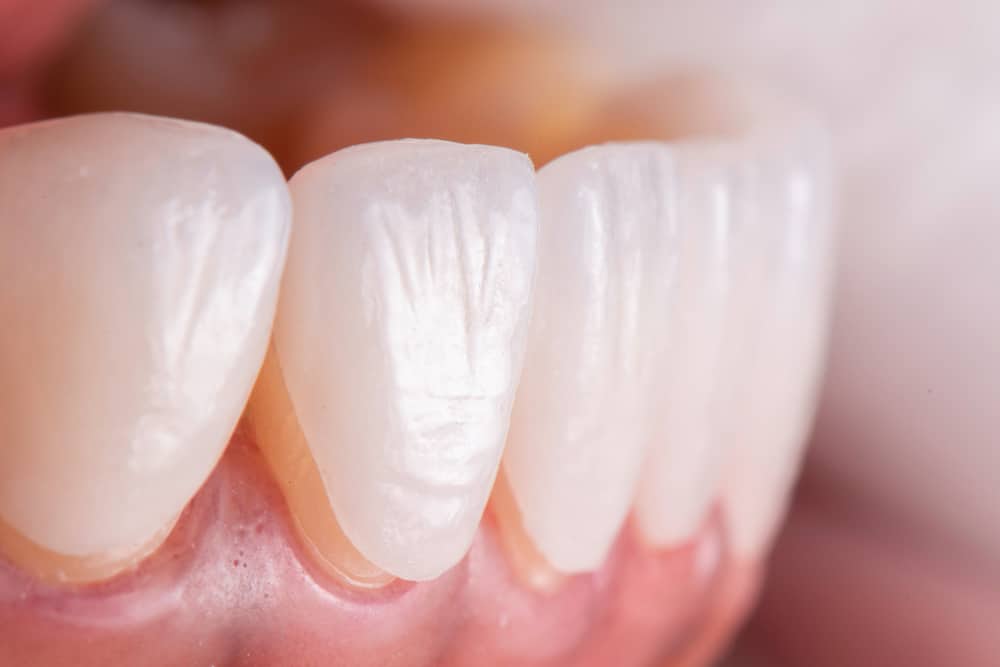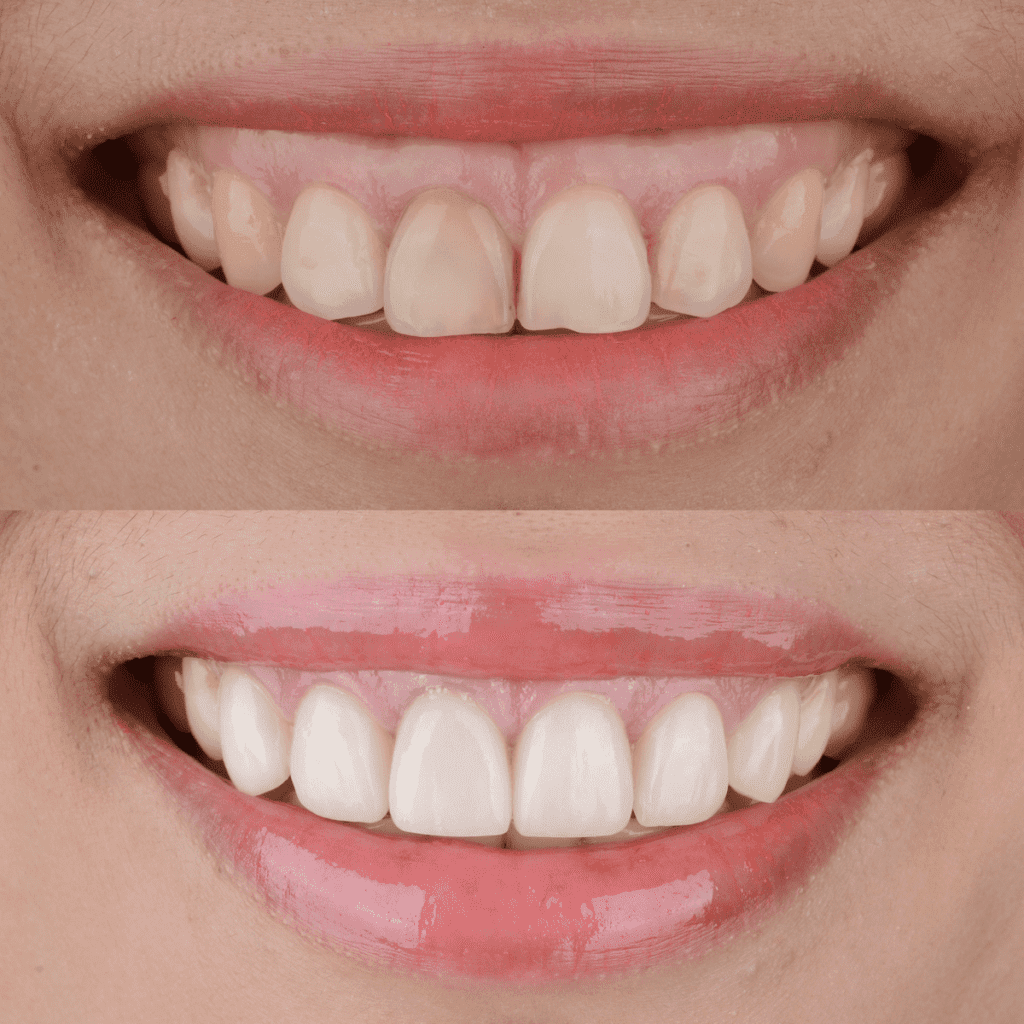Dental Veneers
Perfect your look with veneers and smile with confidence.


Introduction to Dental Veneers
Veneers offer a great solution for improving the aesthetics of your mouth. Nine out of ten Australians with dental concerns have experienced embarrassment over their teeth or smile, and with the popularity of cosmetic procedures at an all-time high, there’s no better time to take the plunge and get your dream smile with veneers.
What Are Veneers?
Dental veneers are custom-made shells that adhere to your teeth, designed to cover the front surface. They’re made from thin layers of porcelain or resin composite materials, firmly bonded to your natural teeth. Veneers are incredibly customisable and can change the shape, size, colour, or length of your teeth.
Types of Veneers
Veneers come in various types to suit different preferences and requirements. The most common types are porcelain laminate veneers and composite resin veneers.
- Porcelain Laminate Veneers: Thin “shells” of porcelain that are bonded to the front of the tooth.
- Composite Resin Veneers: A composite material that is applied in layers directly on the tooth.
Natural-Looking Veneers at Mona Vale Dental
At Mona Vale Dental, we specialise in beautiful, natural-looking smiles. Our custom-made veneers boost confidence and help our clients enjoy smiling again. With a team of skilled dental professionals and state-of-the-art technology, we make veneers that fit in with your natural teeth. Our veneers can enhance the appearance of a single tooth or multiple teeth.

Creating Beautiful, Natural Smiles With Veneers
Our veneers are custom-designed for each patient, allowing for the improvement of various aspects of teeth, including their shape, size, and colour. We offer both porcelain and composite options and will help you find a solution to fit your needs and budget.
Who Is a Candidate for Dental Veneers?
Ideal candidates for dental veneers are individuals with healthy teeth and gums looking for cosmetic improvements. Veneers can correct minor misalignments, discolourations, and imperfections, providing a lasting solution.
The Advantages of Choosing Veneers
- Chipped, cracked, or broken teeth
- Gaps between teeth
- Slightly crooked teeth
- Teeth that look too short, small, or uneven
- Irregularly shaped or eroded teeth
- Fillings that look obvious
- Stained or discoloured teeth
- Minor crowding in the mouth
How Veneers Can Benefit You
- Improve Appearance: Veneers can significantly improve the shape, size, and colour of your teeth, contributing to a more attractive smile.
- Cover Imperfections: They are perfect for closing small gaps, hiding chips, and covering stains, ensuring your teeth look their best.
- Enhance Confidence: Veneers create a balanced, whiter smile that boosts confidence, allowing you to smile freely and confidently.
Common Myths and Concerns About Veneers
Some people hesitate to go for dental veneers. There are a few common misconceptions about their durability, appearance, and upkeep. Concerns often arise about veneers falling out, not matching the natural appearance of teeth, having a short lifespan, resembling piano keys, or appearing unnaturally white.
At Mona Vale Dental, we can address these concerns directly with Digital Smile Design. By using DSD in our consults, we guarantee quick and precise procedures, faster recovery times, and a high success rate. Our custom-designed veneers debunk the myths, giving you a smile that’s both beautiful and functional.
Digital Smile Design: Test Drive Your Smile
Mona Vale Dental uses Digital Smile Design to simulate and design the perfect smile for our patients. We also use technology to simulate the outcome before your treatment begins, giving you confidence in the result. This all means a comfortable, predictable process to achieve the look you want, saving you time and money.
The Digital Smile Design Process
Digital Smile Design (DSD) starts with a detailed analysis of your facial and dental structures. We use high-quality photographs and videos to study the relationship between the teeth, gums, lips, and smile. Then, a digital mock-up of your new smile is created. DSD allows for adjustments before the final application, and we try as many configurations as it takes until you’re happy! Digital Smile Design guarantees a result that truly enhances your facial features.
Composite Veneers vs. Porcelain Veneers
There are benefits to both composite and porcelain veneers, but they differ in application, durability, and look. Porcelain veneers are highly recommended as they last longer and tend to look more like natural teeth. Composite veneers are more affordable and quicker to apply.

What Are Porcelain Laminate Veneers?
What Are Composite Resin Veneers?
Porcelain or Composite: Which Should You Choose?
The choice between porcelain and composite veneers depends on several factors. These could include what your specific needs are, your budget, and the desired outcome. At Mona Vale Dental and Implant Centre, we offer both options. However, we usually recommend getting porcelain veneers if your budget allows, since they last longer and give a far superior aesthetic result.
The Procedure: What to Expect
The process of getting veneers involves consultation, design and test drive, preparation, and delivery of the veneers. Porcelain veneers require a few visits for completion. Composite veneers can take fewer, although still require more than one visit.
Our Complimentary Consultation Process
At Mona Vale Dental we offer a complimentary consultation to kick-start the process to see whether veneers are a good option for your smile. We explain the process and see what will work best for you.
Following this visit, the design process starts, using Digital Smile Design to find your perfect look. Veneers should replicate the natural look, shape, texture, and silhouette of your teeth. DSD allows us to do just that. We can then preview your smile and make sure that the final result meets, and exceeds, your expectations.
How Veneers Are Applied
The application process for veneers differs depending on the type chosen. For porcelain laminate veneers, a small layer of your tooth’s enamel is removed to ensure a flush fit. After this preparation, temporary veneers are usually applied to help with any sensitivity or while your custom ones are being crafted in a dental lab.
Composite resin veneers are applied more straightforwardly. The composite material is applied directly to the tooth in small amounts and sculpted to look as natural as possible. The material is applied and hardened in a single visit. Both methods end with a final touch-up to make sure your new veneers look just like your natural teeth, giving you a great smile.

How Much Are Veneers in Australia?
Although costly, getting dental work done to protect and improve your smile is an investment you won’t regret. The price of veneers in Australia depends on multiple factors, from the type of material to the complexity of the case. At Mona Vale Dental, we offer interest-free and flexible payment plans for those who can’t afford to pay the full cost upfront. Contact our team if you’d like more detailed information about pricing.
Porcelain Laminate Veneers Cost
Composite Resin Veneers Cost
Caring for Veneers Long-Term
How Long Do Dental Veneers Last?
With proper care, your veneers can last for several years, depending on the type and how well they are looked after. Porcelain laminate veneers can last from 10 to 12 years. Composite resin veneers need to be replaced sooner since they last for around 4 to 8 years.
Proper Maintenance for Your Veneers
Maintaining your veneers involves regular dental hygiene practices, avoiding certain foods and habits that could damage them, and regular dental check-ups.
- Cleaning Veneers: Use non-abrasive toothpaste and a soft-bristled toothbrush to clean your veneers gently. Visit your dentist every six months for a professional cleaning session that removes tartar from hard-to-reach places.
- Foods to Avoid: Try to limit foods that can stain or damage veneers, such as coffee or hard candies. If you can’t resist, make sure you chew carefully and rinse your mouth after consuming anything that stains your teeth.
- Damaging Habits: Avoid using your teeth as tools, biting into hard objects, or putting too much pressure on your teeth. Using your mouth to open bottles or biting other tough materials could dislodge or crack your veneers.
Get Your Dream Smile With Mona Vale Dental
At Mona Vale Dental, we don’t just offer veneers; we deliver the key to your dream smile and a boost in confidence that will change your life. Our expert team specialises in crafting veneers that are indistinguishable from your natural teeth, promising a stunning, natural-looking smile that you’ll be eager to show off.
Don’t let another day go by wishing for a better smile. Book your complimentary consultation with us today and take the first step towards a radiant, confident you. Let us turn your dream smile into reality.
Request an Appointment Today
FAQs About Veneers
Can veneers be done in one day?
Composite veneers can often be completed in a single visit, while porcelain veneers require multiple appointments.
Do veneers look real?
Is it painful to get veneers?
Most patients experience little to no discomfort during the veneer application process, with local anaesthesia used to minimise any potential pain.
What are the differences between veneers and crowns?
Veneers cover only the front surface of a tooth, while crowns encase the entire tooth, providing more extensive restoration.
Do people regret veneers?
Most patients are satisfied with their veneers, enjoying the enhanced appearance and function of their smiles.




